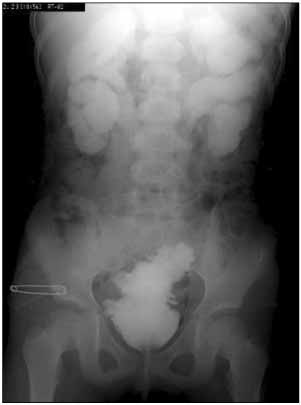Korean J Urol.
2007 Oct;48(10):1058-1063. 10.4111/kju.2007.48.10.1058.
Hinman Syndrome: Long Term Follow up of 14 Case
- Affiliations
-
- 1Department of Pediatric Urology, Urological Science Institute, Yonsei University College of Medicine, Seoul, Korea. swhan@yumc.yonsei.ac.kr
- KMID: 2139739
- DOI: http://doi.org/10.4111/kju.2007.48.10.1058
Abstract
-
PURPOSE: Hinman syndrome is the most severe form of nonneurogenic neurogenic bladder causing damage of the upper urinary tract. Fourteen patients with Hinman syndrome followed at our institution were evaluated for their clinical characteristics and prognosis. Here we report the findings of this series of patients for this poorly understood syndrome.
MATERIALS AND METHODS
The medical records of 14 patients, 8 boys and 6 girls, diagnosed with Hinman syndrome from March 1993 to June 2006 were reviewed. The mean duration of follow up was 69 months. The ultrasonography, 99(m) Tc-dimercaptosuccinic acid renal scan(DMSA), voiding cystourethrogram(VCUG), and urodynamic study(UDS) results were retrospectively analyzed and efficacy of each treatment method was evaluated based on the medical records on follow up.
RESULTS
Hydronephrosis of grade III or greater on ultrasonography and renal scarring of both kidneys on the DMSA renal scan were observed in 12 and 14 patients, respectively. Severe bladder trabeculation and high grade VUR(IV, V) were observed on the VCUG in 14 and 8 patients, respectively. Decreased bladder compliance on the UDS was noted in 13 and detrussor-sphincter dyssynergia(DSD) was observed in eight. Medical treatment was not effective in all 14 cases and six patients who underwent botulinum injection of the bladder were unresponsive to that treatment as well. In spite of conservative treatments such as clean intermittent catheterization(CIC), seven patients eventually underwent bladder augmentations after a mean period of thirty-seven months from diagnosis because of concern about the loss of bladder capacity and renal function. One patient who did not perform CIC progressed to end-stage renal disease and had to be transferred to pediatric nephrology for dialysis.
CONCLUSIONS
Patients diagnosed with the Hinman syndrome were treated similar to patients with neurogenic bladder. However, from the long- termfollow up data at our outpatient clinic, many patients eventually had bladder augmentation to prevent further loss of bladder capacity and renal function. Therefore, urologists must not hesitate in performing such treatment when necessary.
Keyword
MeSH Terms
Figure
Reference
-
1. Hinman F. Nonneurogenic neurogenic bladder. 1971. American Urological Association;16–20.2. Hinman F, Baumann FW. Vesical and ureteral damage from voiding dysfunction in boys with neurologic or obstructive disease. J Urol. 1973. 109:727–732.3. Hinman F Jr. Nonneurogenic neurogenic bladder (the Hinman syndrome)--15 years later. J Urol. 1986. 136:769–777.4. Paquin AJ Jr, Marshall VF, McGovern JH. The megacystis syndrome. J Urol. 1960. 83:634–646.5. DeLuca FG, Fisher JH, Swenson O. Review of recurrent urinary-tract infections in infancy and early childhood. N Engl J Med. 1963. 268:75–77.6. Williams DI, Hirst G, Doyle D. The occult neuropathic bladder. J Pediatr Surg. 1974. 9:35–41.7. Mix LW. Occult neuropathic bladder. Urology. 1997. 10:1–9.8. Fernbach SK, Maizels M, Conway JJ. Ultrasound grading of hydronephrosis: introduction to the system used by the Society for Fetal Urology. Pediatr Radiol. 1993. 23:478–480.9. International Reflux Study Committee. Medical versus surgical treatment of primary vesicoureteral reflux: a prospective international reflux study in children. J Urol. 1981. 125:277–283.10. Johnson JF, Hedden RJ, Piccollello ML, Wacksman J. Distention of the posterior urethra: association with nonneurogenic neurogenic bladder (Hinman syndrome). Radiology. 1992. 185:113–117.11. Hinman F. Syndrome of vesical incoordination. Urol Clin North Am. 1980. 7:311–319.12. Allen TD, Bright TC. Urodynamic patterns in children with dysfunctional voiding problems. J Urol. 1978. 119:247–249.13. Alderson K, Holds JB, Anderson RL. Botulinum-induced alteration of nerve-muscle interactions in the human orbicularisoculi following treatment for blepharospasm. Neurology. 1991. 41:1800–1805.14. Yang KM, Jeon HJ, Han SW. The clinical experience of the ureterocystoplasty in neurogenic bladder. Korean J Urol. 2005. 46:708–712.15. Mulholland SG, Yallas SV, Raezer DM, Duckett JW. Primary external urethral sphincter hyperkinesia in a boy. Urology. 1974. 4:577–580.16. Hinman F, Baumann FW. Complications of vesicoureteral operations from incoordination of micturition. J Urol. 1976. 116:638–643.17. Yang CC, Mayo ME. Morbidity of dysfunctional voiding syndrome. Urology. 1997. 49:445–448.
- Full Text Links
- Actions
-
Cited
- CITED
-
- Close
- Share
- Similar articles
-
- A Patient with Hinman's Syndrome who Underwent Renal Transplantation Using a Pre-existing Cutaneous Ureterostomy
- A Case of Ring Chromosome 14 Syndrome Presenting with Intractable Epilepsy
- A case of nonneurogenic neurogenic bladder (Hinman syndrome)
- A Case of Hinman Syndrome(Nonneurogenic Neurogenic Bladder)
- Long-term follow-up study and long-term care of childhood cancer survivors


